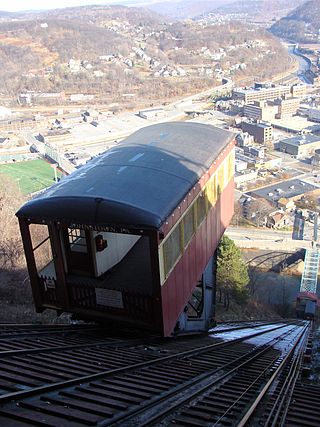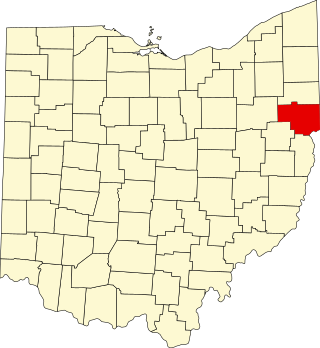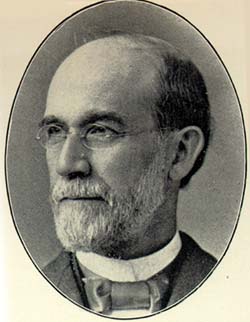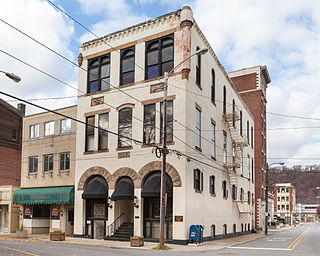
Johnstown is the largest city in Cambria County, Pennsylvania, United States. The population was 18,411 as of the 2020 census. Located 57 miles (92 km) east of Pittsburgh, it is the principal city of the Johnstown metropolitan area, which includes Cambria County. It is also part of the Johnstown–Somerset combined statistical area, which includes both Cambria and Somerset Counties.

The Allegheny Portage Railroad was the first railroad constructed through the Allegheny Mountains in central Pennsylvania. It operated from 1834 to 1854 as the first transportation infrastructure through the gaps of the Allegheny that connected the midwest to the eastern seaboard across the barrier range of the Allegheny Front. Approximately 36 miles (58 km) long overall, both ends connected to the Pennsylvania Canal, and the system was primarily used as a portage railway, hauling river boats and barges over the divide between the Ohio and the Susquehanna Rivers. Today, the remains of the railroad are preserved within the Allegheny Portage Railroad National Historic Site operated by the National Park Service.

The Johnstown Inclined Plane is a 896.5-foot (273.3 m) funicular in Johnstown, Cambria County, in the U.S. state of Pennsylvania. The incline and its two stations connect the city of Johnstown, situated in a valley at the confluence of the Stonycreek and the Little Conemaugh rivers, to the borough of Westmont on Yoder Hill. The Johnstown Inclined Plane is billed as the "world's steepest vehicular inclined plane". It can carry automobiles and passengers, up or down a slope with a grade of 71.9%. The travel time between stations is 90 seconds.

The South Fork Fishing and Hunting Club was a Pennsylvania corporation which operated an exclusive and secretive retreat at a mountain lake near South Fork, Pennsylvania, for more than fifty extremely wealthy men and their families. The club was the owner of the South Fork Dam, which failed during an unprecedented period of heavy rains, resulting in the disastrous Johnstown Flood on May 31, 1889.

The Cambria Iron Company of Johnstown, Pennsylvania was a major 19th-century industrial producer of iron and steel founded in 1852. The company had the nation's largest steel foundry in the 1870s and was renamed the Cambria Steel Company in 1898. The company used many innovations in the steelmaking process, including those of William Kelly and Henry Bessemer. The company was acquired in 1923 by the Bethlehem Steel Company. The company's historic facilities, extending some 12 miles (19 km) along the Conemaugh and Little Conemaugh Rivers, are a National Historic Landmark District.

This is a list of the National Register of Historic Places listings in Columbiana County, Ohio.

Addison Hutton (1834–1916) was a Philadelphia architect who designed prominent residences in Philadelphia and its suburbs, plus courthouses, hospitals, and libraries, including the Ridgway Library and the Historical Society of Pennsylvania. He made major additions to the campuses of Westtown School, George School, Swarthmore College, Bryn Mawr College, Haverford College, and Lehigh University.

The Inclined Plane Bridge is a 237-foot (72 m), Pennsylvania through truss bridge that spans Stonycreek River in Johnstown, Cambria County, in the U.S. state of Pennsylvania. It connects the city to the lower station of the Johnstown Inclined Plane. The bridge was listed on the National Register of Historic Places in 1988 and was documented by the Historic American Engineering Record (HAER) in 1997.

The Andrew Carnegie Free Library & Music Hall is a public library and music hall located at 300 Beechwood Avenue in Carnegie, Pennsylvania. Like hundreds of other Carnegie libraries, the construction of the ACFL&MH, which opened in 1901, was funded by industrialist Andrew Carnegie. The ACFL&MH has been recognized as a historic landmark and appears on the List of Pittsburgh History and Landmarks Foundation Historic Landmarks and the National Register of Historic Places.

A. W. Buck House is a historic home located at Ebensburg, Cambria County, Pennsylvania. It was built in 1889, and is a high style Queen Anne style dwelling. A two-story wing with end tower was built in 1903. It is a 2+1⁄2-story, three-bay brick building. It features an eight sided, three-story tower and a wrap-around porch. It was originally built as a private residence. In 1923, it was purchased by the Roman Catholic Diocese of Altoona-Johnstown as a convent for the Sisters of St. Joseph.

The Grand Army of the Republic Hall is an historic clubhouse building, which is located in Johnstown, Cambria County, Pennsylvania.

Nathan's Department Store is a historic department store building located at Johnstown, Cambria County, Pennsylvania. It was built in 1917, and is a four-story brick building with a finished basement. The front facade features glazed architectural terra cotta in a simplified classical motif. The building was damaged in the Flood of 1977. For many years the building housed an S. S. Kresge store.

Colver Historic District is a national historic district located at Barr Township and Cambria Township in Cambria County, Pennsylvania. The district includes 336 contributing buildings, 5 contributing sites, and 3 contributing structures. The district consists of residential areas, coal mining resources, Cambria and Indiana Railroad shop buildings, and a dairy farm associated with the Ebensburg Coal Company's mine and developed between 1911 and 1943. Notable buildings include a variety of brick and frame workers' housing, the Ebensburg Coal Company office building (1914), stone company store (1912), Colver Amusement Company (1912), Colver Hotel (1912), Colver Presbyterian Church (1915), public school (1927), hospital (1914), Roundhouse No. 1 (1918), Roundhouse No. 2 (1920), and main power building (1911).

Revloc Historic District is a national historic district located at Cambria Township in Cambria County, Pennsylvania. The district includes 203 contributing buildings, one contributing site, and one contributing structure. The district consists of residential areas and utilitarian industrial buildings associated with the Monroe Coal Mining Company and developed between 1917 and 1944. The mine was serviced by the Cambria and Indiana Railroad. Notable buildings include a variety of brick and frame miners' housing, stone company store (1918), payroll office, company boiler house, supply house, machine and blacksmith shop, Revloc Presbyterian Church (1923), Most Holy Redeemer Catholic Church (1924), and Revloc School.

Downtown Johnstown Historic District is a national historic district located at Johnstown in Cambria County, Pennsylvania. The district includes 109 contributing buildings, 4 contributing sites, and 1 contributing structure in the central business district and surrounding residential areas of Johnstown. The district includes some buildings dated before the Johnstown Flood, but the majority date from 1890 to 1930. Notable buildings include the Alma Hall (1884), Bantley Building (1888), Stenger Dry Goods Store (1883), Widmann Building (1892), Cambria Iron Office Building, St. Vincent DePaul Building, Swank Building (1907), Glosser Brothers Department Store (1905), Johnstown City Hall (1900), former U.S. Post Office (1912), State Theater (1926), U.S. Post Office (1938), Franklin Street United Methodist Church (1869), St. John Gualbert Cathedral (1896), First United Methodist Church (1911), Elks Building (1903), and Moose Building (1917). Located in the district and listed separately are the Cambria Public Library Building, G.A.R. Hall, and Nathan's Department Store.

Cambria City Historic District is a national historic district located at Johnstown in Cambria County, Pennsylvania. The district includes 198 contributing buildings and 1 contributing structure in a predominantly working-class residential area of Johnstown. Though predominantly residential, it also includes a small business district and industrial buildings such as a former brewery, bottling plant, and slaughter house, along with a notable collection of churches, schools, and fire station. The district includes some buildings dated before the Johnstown Flood, but the majority date from 1890 to 1920. Notable buildings include the collection of two-story, balloon frame, detached and semi-detached dwellings, Fifth Avenue Hotel (1889), Pollack Building (1905), former Cambria Fire Hose and Ladder Company (1890), former Germana Brewery (1907), August and Louisa Mayer Building (1907), Tulip Bottling Company (1913-1949), St. Casimer's Polish Church (1907), Immaculate Conception Church (1908), St. Stephen's Slovak Church (1914), St. Columba Church (1914), St. Mary's Greek Catholic Church (1922), Venue Of Merging Arts, Hungarian Reformed Church (1902), and First Catholic Slovak Band Hall (1913-1949). The contributing structure is the Minersville Bridge (1914).

Moxham Historic District is a national historic district located at Johnstown in Cambria County, Pennsylvania. The district includes 330 contributing buildings in a predominantly residential area in southern Johnstown. There are 315 contributing dwellings, 17 former carriage house / horse barns, 21 commercial buildings, 10 churches, and one former school. The district includes five contributing buildings dated before the Johnstown Flood, but the majority date from 1890 to 1930. The dwellings include notable examples of popular architectural styles including Bungalow/craftsman, Colonial Revival, and American Foursquare. Notable non-residential buildings include St. Patrick's Catholic Church (1905), former Calvary Methodist Church (1894), Allegheny Wesleyan Methodist Church (1898), Grove Avenue Methodist Church (1902), Second Presbyterian Church (1914), and former Cypress Avenue School (1900).

Carnegie Free Library is a historic Carnegie library building located at Connellsville, Fayette County, Pennsylvania. It was designed and built in 1901, with funds partly provided by the philanthropist Andrew Carnegie. Carnegie provided $50,000 toward the construction of the Connellsville library. The grant was commissioned by Carnegie on April 22, 1899; it was the 13th library that he commissioned in America. It is a two-story Ohio buff stone structure with basement in the Italian Renaissance Revival style. The exterior features a terra cotta cornice and red Spanish tile roof. It measures 92.2 feet (28.1 m) by 74.6 feet (22.7 m).
Peoples Natural Gas Park is located near the Cambria Iron National Historic Landmark at the junction of the Conemaugh and Stoneycreek Rivers and there is a view of the Stone Bridge and the Johnstown Inclined Plane.
Located on 3.5 acres, the park has an outdoor pavilion that seats 600 as well as the adjacent Oilhouse that seats about 560.
Funded by Peoples Natural Gas for The Johnstown Area Heritage Association.
The newly completed Peoples Natural Gas Park is the home of the AmeriServ Flood City Music Festival and many other special events produced by the Johnstown Area Heritage Association (JAHA) and other organizations. The park includes landscaping, new restrooms, pathways and new sidewalks, ornamental fencing and gates around the perimeter.

Minersville Historic District is a national historic district located at Johnstown in Cambria County, Pennsylvania. The district is a working-class neighborhood of privately and company built housing running along the north side of the Conemaugh River.






















